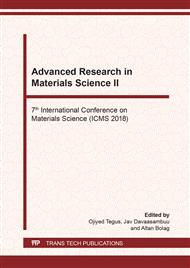[1]
A.K. Padhi, K.S. Nanjundaswamy, J.B. Goodenough, Phospho-olivines as Positive-Electrode Materials for Rechargeable Lithium Batteries, Electro-chem. Soc. 144 (1997) 1188.
DOI: 10.1149/1.1837571
Google Scholar
[2]
J. Chen, M.S. Whittingham, Hydrothermal Synthesis of Lithium Iron Phosphate, Electrochem. Commun. 8 (2006) 855.
Google Scholar
[3]
H. Huang, S.-C. Yin, L.F. Nazar, Approaching Theoretical capacity of LiFePO4 at Room Temperature at High Rates, Electrochem. Solid-State Lett. 4 (2001) A170.
DOI: 10.1149/1.1396695
Google Scholar
[4]
S.-Y. Chung, J.T. Bloking, Y.-M. Chiang, Electronically conductive Phospho-olivines as lithium storage electrodes, Nature Mater. 1 (2002) 123.
DOI: 10.1038/nmat732
Google Scholar
[5]
H.C. Wu, C.Y. Su, D.T. Shieh, M.H. Yang, N.L. Wu, Enhanced High-temperature cycle life of LiFePO4- based li-ion batteries by vinylene Carbonate as Electrolyte additive, Electrochem. Solid-State Lett. 9 (2006) A537.
DOI: 10.1149/1.2351954
Google Scholar
[6]
H.H. Chang, C.C. Chang, H.C. Wu, Z.Z. Guo, M.H. Yang, Y.P. Chiang, H.S. Sheu, N.L. Wu, J. Kinetic study on low-temperature synthesis of LiFePO4 via solid-state reaction, Power Sources 158 (2006) 550.
DOI: 10.1016/j.jpowsour.2005.09.005
Google Scholar
[7]
T. Maxisch and G. Ceder, Elastic properties of olivine LixFePO4 from first principles, Phys. Rev. B 73, 174112 (2006).
Google Scholar
[8]
C. Zhu, Size Effects on Lithium Storage and Phase Transition in LiFePO4 /FePO4 System, Doctor of Philosophy (Max-Planck-Institut fuer Festkoerperforschung Stuttgart, Germany, 2013).
Google Scholar
[9]
D. Morgan, A. Van der Ven, and G. Ceder, Li conductivity in LixMPO4 (M = Mn, Fe, Co, Ni) olivine materials, Electrochem. Solid-State Lett.7, A30 (2004).
DOI: 10.1149/1.1633511
Google Scholar
[10]
Chuying Ouyang, Siqi Shi, Zhaoxiang Wang, Xuejie Huang and Liquan Chen, First-principles study of Li ion diffusion in LiFePO4, Phys. Rev. B 69, 104303~(2004).
Google Scholar
[11]
L. Wang, F. Zhou, Y. S. Meng, and G. Ceder First-principles study of surface properties of LiFePO4: Surface energy, structure, Wulff shape, and surface redox potential, Phys. Rev. B 76, 165435 (2007).
DOI: 10.1103/physrevb.76.165435
Google Scholar
[12]
Hao-Hsun Chang, Chun-Chih hang Hung-Chun Wu, Mo-Hua Yang Hwo-Shuenn Sheu , Nae-Lih Wu, Study on dynamics of structural transformation during charge/discharge of LiFePO4 cathode, Electrochem. Commun. 10 (2008) 335-339.
DOI: 10.1016/j.elecom.2007.12.024
Google Scholar
[13]
Guigui Xu, Kehua Zhong, Jian-Min Zhang, Zhi-Gao Huang, First-principles study of structural, electronic and Li-ion diffusion properties of N-doped LiFePO4 (010) surface, Solid State Ionics Volume 281, 15 November 2015, Pages 1-5.
DOI: 10.1016/j.ssi.2015.08.013
Google Scholar
[14]
P Blaha, K Schwarz, G Madsen, D Kvasnicka and J luitz, WIEN2k User's Guide Vienna University of Technology (June 2013).
Google Scholar
[15]
Robert G. Parr. and Yang W. Hao, Density – Functional Theory of Atoms, Oxford University Press, (1989).
Google Scholar
[16]
J. P. Perdew, K. Burke and M. Ernzerhof, Generalized Gradient Approximation Made Simple, Phys. Rev. Lett. 77, 3865-3868 (Oct. 1996).
DOI: 10.1103/physrevlett.77.3865
Google Scholar


